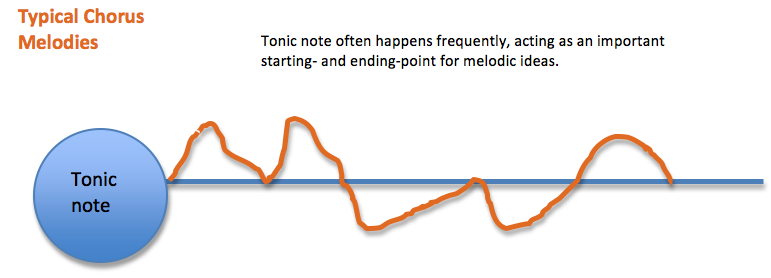 Discover the 11 secrets that pro songwriters have known for decades. “The Essential Secrets of Songwriting” 10-eBook DELUXE Bundle is being used by thousands of songwriters to take their music to a new level of excellence. Get today’s deal.
Discover the 11 secrets that pro songwriters have known for decades. “The Essential Secrets of Songwriting” 10-eBook DELUXE Bundle is being used by thousands of songwriters to take their music to a new level of excellence. Get today’s deal.
It’s relatively easy to hear the difference between verse and chorus chord progressions. Mainly, chorus progressions are shorter and less harmonically venturous. They tend to stick closer to the tonic chord, and therefore contain features that keep that tonic chord front and centre.
Like everything in music, that’s not always true. On Rush’s album “Clockwork Angels”, the song “Halo Effect” features a verse with a rather straightforward progression: C G/B Em D C G/B C. The chorus is where the tonality becomes a bit more ambiguous: D5(no3) C Dm C Bb G.
But what about differences between verse and chorus melodies? What sorts of things should you keep in mind as you write your next song? The two most important ones, features I’ve mentioned often on this blog, are:
- Tonic focus. A chorus melody, like chords, tends to focus on the tonic note. So if your song is in G major, you’ll want to create melodic shapes that move in and around G. It’s common to see that a chorus melody will start on the tonic note, move away and then quickly back to that note, creating hook-like shapes that are easy for the audience to remember, and easy to sing.
- Repetitive ideas. A chorus melody will often be comprised of short ideas that get sung a lot.
To compare the two visually, this is what we’re talking about:
As you can see, the tonic note happens in passing, not often on strong beats or at the beginning or end of melodic fragments. In most cases, repetition can be an important feature of verses, and that’s certainly true of simpler, MOR pop songs. But if song melodies feature any kind of wandering characteristic, you’re more likely to find it in a verse, with the chorus tending toward repetition:
In a chorus, you’re more likely to hear the tonic note being highlighted, with repetitive ideas constantly moving away from and back toward that note. It gives a sense of closure and finality to the music. That’s one of the reasons that choruses are easy to sing over and over, while verses don’t work that way very often: they usually need the chorus to follow up.
Those differences between verse and chorus melodies are an important part of the contrast principle of musical composition. When an audience hears a verse with a wandering melody and infrequent visiting of the tonic note, they instinctively want to hear those elements in a chorus.
______________
 Written by Gary Ewer. Follow on Twitter.
Written by Gary Ewer. Follow on Twitter.
 “The Essential Secrets of Songwriting” eBook Bundle packages look at songwriting from every angle, and have been used by thousands of songwriters. How to use chords, write melodies, and craft winning lyrics. Get today’s Deluxe Bundle deal:
“The Essential Secrets of Songwriting” eBook Bundle packages look at songwriting from every angle, and have been used by thousands of songwriters. How to use chords, write melodies, and craft winning lyrics. Get today’s Deluxe Bundle deal:













Hello Gary . Thanks to you, I can read good articles every time.
I have a question.
I looked through the sheet music.
Verse section (Am G EmD) – (Am G C )
So there were two patterns.
and Chorus section ( D C Bb G ) pattern
But on the sheet music, it says DMaj Key
so I really want to know why these chords appear ( C , Am , Bb )
It looks to me that the song is actually traveling around a bit from one key centre to another. Certainly the verses are dwelling on A minor. The chorus works as D major, even though the D and G chords are the only diatonic chords — chords that exist naturally in the given key. The other two chords, C and Bb, are the flat-VII and flat-VI of D major. Those are actually fairly common non-diatonic chords in the pop genres, because songwriters like the descending bass line they create: D C Bb G, in this case. A classic rock variation on that progression: Chicago’s “25 or 6 to 4”: Am C/G D/F# F E
There’s not an overly close relation between the verse key of A minor and the chorus key of D major, so I am assuming that the song you’re talking about did some kind of abrupt modulation from one to the other. That kind of shift can work quite nicely, and so there’s probably not a lot to be gained by trying to figure out how they got from one to the other.
Hope this helps,
-Gary
Thank you very much for your kind advice.
Actually I purchased your e-books and I study it in parallel with the postings.
It’s been very helpful. 🙂
Reblogged this on I Write The Music.
Hello Gary, I’m very uncertain on how to do this and I need help. I’m 17 and I’ve been writing for over a year now. I’ve been researching for a century and came across your website today and we’re both from Dartmouth! Is there any way you could teach me? Do you have individual lessons or songwriting workshops I could go to?
Hi Josh:
Well, sorry.. I’m not from Dartmouth, and though I do occasional workshops, I don’t have a lot of time to do private lessons. The workshops are generally set up by other individuals, and if one comes up in your area, I’d be happy to let you know.
Another thought… starting sometime in early 2015, I am planning to offer online video-based lessons that will offer both individual and group instruction in songwriting. I’m still in the planning stages of that, and so keep checking my blog for more info on that.
All the best,
-Gary
Please let me know about the workshops, even if they’re at Dal! I look forward to studying music there so I don’t mind the distance. Also I was wondering if you could refer me to any songwriters from here that could help me… I have a lot of questions. Anyway! Thank you for the reply Gary, I’ll keep reading! Your blog’s great.